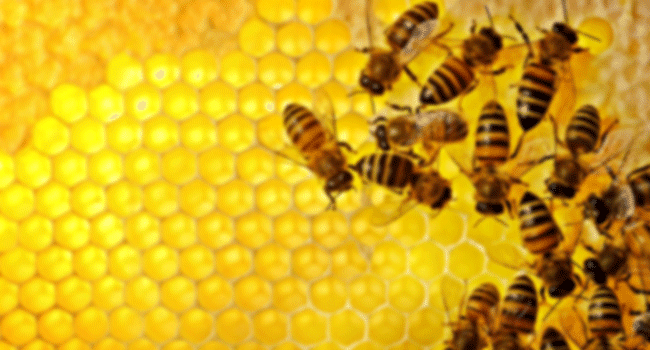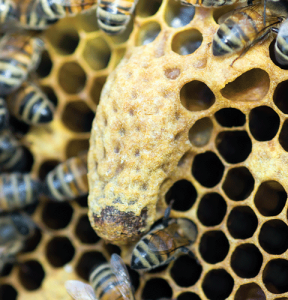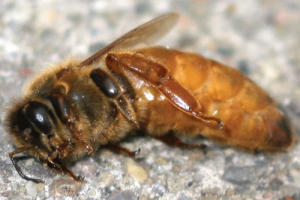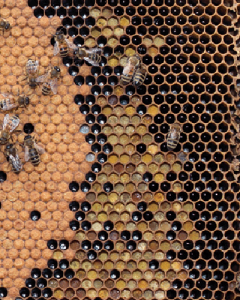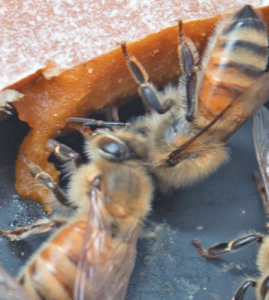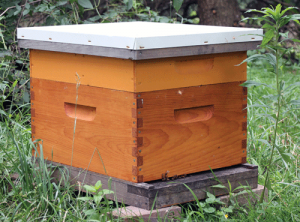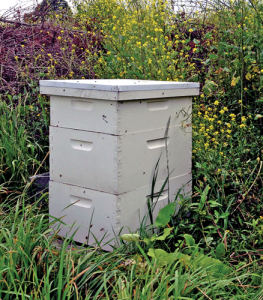
James E. Tew
Stay Connected
http://onetew.com
Why are some bee things the way they are?
Why are things the way they are in beekeeping? Such things/questions/oddities or quirks are everywhere in the honey bee world. I don’t go looking for these peculiarities, they just pop up. My response is generally, “Humph – I wonder why it’s done that way?” In some cases, though the answer may exist, I simply do not know it. Maybe you readers or some little-known literature citation can elucidate all that follows.
Why do queen cells have dimples?
Why are queen cells dimpled? Why not just thicker or maybe thick and smooth? Nope, queen cells classically look like a peanut? Which then begs the question, “Why is a peanut shell dimpled?” I know why golf balls are dimpled but I have no idea why queen cells and peanut shells are dimpled.
When asked and without hesitation, my wife said that a queen cell is dimpled for grasping during and after construction. Well, that is an answer, but not one without holes. Maybe queen cells are dimpled to provide stability and strength the way cell rims provide reinforcement and rigidity. Why would queen cells need that cell attribute? It is not as though the cell moves or the combs shift. Why does the cell need to be heavy-duty?A rival queen can readily cut through the queen cell wall and sting the mouthy rival queen in confinement so it’s not that rugged.
Is this thick, dimpled wall structure for humidity control in a capped cell that is remotely positioned from the bulk of the brood nest? I like that idea (it’s mine), but I have absolutely no idea if it is correct. How about this one – the dimples assist in amplifying “quacking” that a confined queen does to draw attention to herself. We recently were told that bees do have short-range hearing. Maybe this happens – but I doubt it.
So here it is – “Why are queen cells dimpled?” I don’t know.
The famous fight to the death! Virgin queen battles.
It seems biologically sloppy to me that unmated queens must fight in gladiator fashion before moving to the next phase of queen reigning – mating. Nature is usually right, so there must be a reason. I don’t see it.
For discussion, may I say that in a hypothetical hive, seven swarm cells are produced. The old queen leaves with the swarm – meaning that the parent colony must be requeened. This colony has seven chances to accomplish this complicated feat. Again, for discussion, let’s say that four virgin queens emerge at approximately the same time. They are combative and begin to “pipe” – which is kind of nonsensical in itself. Why advertise yourself? Why not sneak around and try to ambush your opponent?1
I would conjecture that time very valuable. It would probably take much longer for queens to randomly find each other than to put an announcement – “Here I am. Let’s do this thing!” – on the comb web internet, and then meet straight away. The sooner the bouts are over the sooner the winner can get on with the process of producing new brood. The season is passing. The first Winter is the worst Winter for a foundling colony. Colony time is very valuable.
I would argue that in some (many?) cases, it is not a good survival strategy to be the first queen out of her incubation cell. If I were a queen, I would sit quietly for a few hours and let the first queens duke it out. Maybe they will hurt each other giving me the upper hand. So, another question. “Is the first queen out, generally the successful queen?” or does she weary in multiple combat situations.
Queens require venom to kill each other. That would mean that virgin queens have venom supplies much sooner than worker bees that take a few days to acquire full venom loads. Does survival advantage go to a queen a few hours older because she has time to produce a bit more venom? Even then, how much venom is required to kill a rival queen? Does she lose her ammo and the succumb to a queen a few hours younger that still has a full venom load?
And what about those mouthy unmated queens still confined to their queen cell? Why don’t they just shut up. By quacking, they attract released queens to their location whereby the cell wall (Remember the unanswered question above?) is torn open and the hapless, mouthy queen is killed within the cell. I can only offer that this odd death of confined queens is part of keeping things moving along. If the emerged queens had, in fact, all been killed, there would still be a cadre of awaiting queens to fill the queenless void. Are there extra queens that are simply not needed so they are quickly killed within the cell; thereby, preventing the combat phase from dragging on and on?
Are the workers involved? It has been reported (I think it has been reported. I have no handy literature citation to confirm my statement.) that workers are able to keep queens confined to their cells. If this is true, an inquisitive beekeeper could ask, “Do all unmated queens release themselves whenever they are matured or do workers continuously reseal cells to control the rate of virgin queen release?)
So here it is – Why do unmated queens fight to the death? I don’t know.
How do bees eat pollen – or do they?
If bees can only consume liquid food, how to they eat pollen? We see pollen packed in brood frames nearly year-round. We know that house bees add honey to the pollen that is gathered by foragers, and we know that the added honey results in the pollen grains fermenting into a product that beekeepers have named “beebread.” I’m happy with all of that.
But I have been wondering how the bees actually – physically – eat the bee bread. I can only assume that they use their mandibles to scrape the stored beebread concoction, mix some of it with what – saliva or thinned honey or even water – and then siphon it up to their buccal cavity? By mixing it with a liquid, may I assume that pollen grains are small enough to be suspended in liquids and swallowed by bees?
- Bee bread. Are the bees eating it or packing it? Why are the pollen cells not filled to the rim? I don’t know.
- Bees liquefying pollen substitute.
Clearly, bees have some system – probably enzymatic – that digests the fermented walls of the pollen grains allowing the contents of a specific grain be available as a protein source – but this is all just my conjecture.
I’m trying to get somewhere with this line of questioning. If bees convert pollen to a drinkable product, why is commercially- produced pollen substitute generally in a solid or paste form? Would the bees be able to take pollen patties more easily and quickly if in a liquid form? I know. I know. It would seem to be easy for the bees to regurgitate some liquid to make a drinkable slurry and consume it that way. I get that.
Even so, would it be easier if supplements were already in liquid form? Should I take my patties, dissolve them in water or possibly water and honey mixed to see if the bees will take it. Better or worse? Presenters have said that pollen patties are primarily consumed by house bees because they obstruct hive activities. What is bothering me is that I normally see tens of bees feeding on a pollen substitute patty – not hundreds and certainly not thousands. Yet there would there be many more bees taking syrup from a feeder.
So, here it is – How do bees like to consume their protein? I don’t know.
Got American Foulbrood, kill and burn
As disappointing and disgusting as it may be, I agree with the disease management scheme that includes killing diseased bees and burning infected equipment. Here’s the rub – and it’s a big one – what if the equipment to be destroyed is new and freshly painted – not old and decrepit like we usually mentally envision diseased equipment? Most likely it should still be burned, but the agony of equipment destruction is much more acute.
J.S., a Bee Culture reader asked a hypothetical thought provoking question – “Okay, say I have American foulbrood and need to destroy the bees and the equipment. But the equipment is something like the Flow Hive or some other high-dollar hive unit – maybe the solar hive.” What then? Well, personally, I’m not sure. The apiary laws in individual states would vary, but I’m sure that some beekeepers’ opinions would not vary at all. I suspect that burning would be the order of the day. Hold that thought . . .
On a separate – but similar – theme, suppose I have had AFB diagnosed in my high-density plastic hives in which I am also using plastic frames. While I have not reviewed all state apiary statutes for this discussion, but a common regulation is to burn the equipment. In many areas, outdoor burns of litter and leaves are prohibited, but even worse would be burning plastic equipment in outdoor areas.
So where is all this going? Nowhere, I’m afraid. Destroying a high-dollar hive would feel the same as destroying two or three regular colonies; therefore, the expense of a expensive hive is not always a justification for not destroying it. It appears that the regulatory details in individual states and individual cases would be important. After consideration, if the decision is still to burn the equipment, would special incinerators be useful? Do we continue with a normal outdoor burn, or do something else entirely? I don’t know what that plan would be. Just as in the high-dollar case, individual situations in individual states would have to have to have a regulatory plan to deal with this old infectious bee disease. In whatever way, and in whatever equipment, this disease must be controlled.
So here it – What should routinely be done with special beekeeping equipment that is contaminated with American foulbrood. I don’t know.
Why are hive entrances on one of the narrow sides (end) of the brood box?
In developmental years long gone, there was a meaningful discussion that went on in the bee literature for decades about hive size and accompanying entrance locations. Indeed, if the entrance was positioned on the long side of the brood box, it was referred to as the “warm way” entrance. If the entrance was positioned on the end (or short wall) of the hive body, it was referred to as the cold-way entrance.
- Standard beehive with traditional cold-way entrance. The entrance could have easily been on the long side. It rarely is.
- This colony and hive equipment had to be destroyed due to American Foulbrood.
If located on the side of the hive, the hanging frames serve as a baffle that disrupt incoming air flow. Alternatively, if located on the end of the hive, the air can come in the front of the hive and move, unabated, up through the frame spaces. I suspect that the heat rising from the wintering cluster would pull the air into the front and out the top ventilation openings.
Here’s the thing. Beekeepers have never been able to tell that bees really like one entrance or the other – front, side, round hole, middle of the bottom board, or nearer the hive top – the bees just seem to want a defendable entrance (as far as we can tell). So how did the major manufacturers of bee hives throughout the world mostly put the entrance on one end? Did beekeepers and manufacturers decide that our bees needed more ventilation? Was a manufacturing decision made due to lumber measurements and production procedures?
Without any evidence from me, I would like to an offer off-the-wall guess. I surmise that the entrance being on the hive body end was simply due to appearance. To the readers who are mathematicians I tried to find a hive body measurement relationship with the Golden Ratio, but I could not immediately see one.
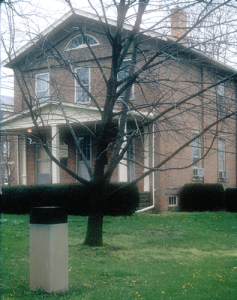
Langstroth’s Greek Revival Cottage is (very) roughly the shape of a beehive – maybe a deep and a super. All of the house side is not pictured.
The typical beehive is oddly in the shape of Langstroth’s Cottage on the campus of Miami University in Oxford, Ohio. Problem is that he moved to that house after he wrote his book, The Hive and The Honey Bee. I realize my concept of Langstroth’s house is a not practical. Coincidental?
Without anything approaching a thorough inspection, the photos I have of antique hives show most entrances are on the end of the brood body. However, the entrance could be on the side or nearly anywhere else. You know, the reason could be nothing more than a beekeeper can stack more colonies on a vehicle if the entrance is on the end of the hive.
So, here it is – Why is the entrance on the short side of a brood nest box? I don’t know.
After keeping bees for low all these many years, I have realized that I don’t know many, many things about the bees’ private world. I’ll keep trying. Thanks for reading and thinking.
1A short audio clip with supporting video of four-five caged queens piping is posted at: https://youtu.be/O9_2gtsVk-8
Dr. James E. Tew, State Specialist, Beekeeping, The Alabama Cooperative Extension System, Auburn University; Emeritus Faculty, The Ohio State University. Tewbee2@gmail.com; http://www.onetew.com; One Tew Bee RSS Feed (www.onetew.com/feed/); http://www.facebook.com/tewbee2; @onetewbee Youtube: https://www.youtube.com/user/onetewbee/videos






